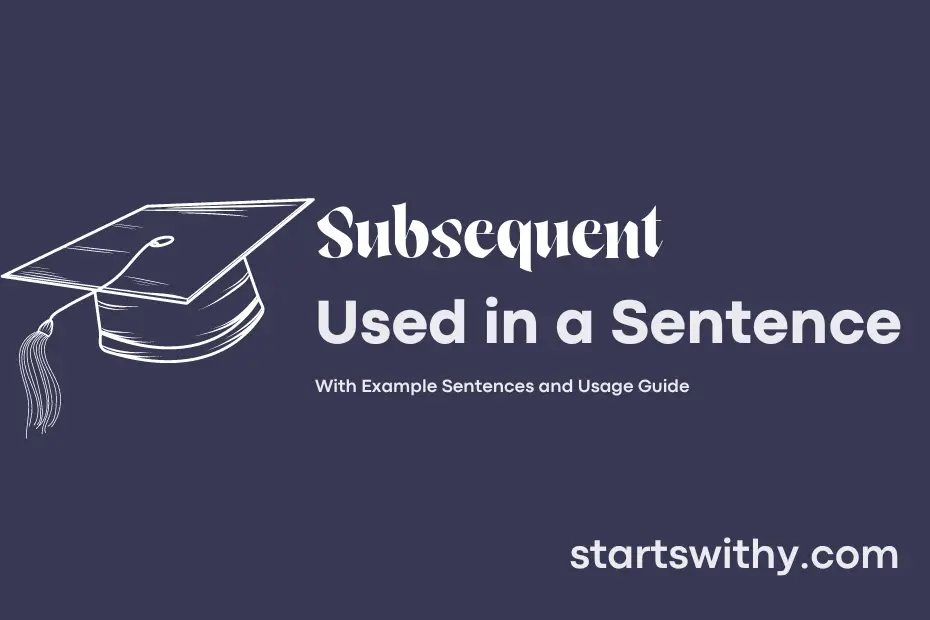Have you ever come across the word “subsequent” while reading or listening to someone speak? “Subsequent” is an adjective that refers to something that comes after or follows something else in a chronological sequence.
This word is commonly used to describe events, actions, or situations that occur in a particular order, with one following the other. Understanding the concept of “subsequent” can help you identify the sequence of events or actions in a story, conversation, or any other narrative.
7 Examples Of Subsequent Used In a Sentence For Kids
- The bell rang, and subsequent to that, it was time for lunch.
- The sun set, and subsequent to that, the stars appeared in the sky.
- We planted seeds, and subsequent to that, we saw tiny plants growing.
- I washed my hands, and subsequent to that, I dried them with a towel.
- The bird chirped, and subsequent to that, it flew away to its nest.
- We read a story, and subsequent to that, we drew pictures about it.
- The rain stopped, and subsequent to that, we saw a rainbow in the sky.
14 Sentences with Subsequent Examples
- Subsequent to your exam, make sure to review your answers for any errors.
- After attending the workshop, the subsequent step is to apply the newly acquired skills in a real-life project.
- Due to the subsequent delays in project submission, the deadline has been extended by a week.
- Subsequent to your presentation, be prepared to answer any questions from the audience.
- The subsequent lecture will cover the more advanced topics in the course syllabus.
- After the semester break, the subsequent session will focus on practical training and internships.
- Subsequent to the college festival, the student council will hold a feedback session to gather suggestions for improvement.
- The subsequent assignment will require you to conduct field research and present your findings.
- After the study group session, the subsequent step is to review the material on your own for better understanding.
- Subsequent to the webinar on career opportunities, students are encouraged to schedule one-on-one sessions with career counselors.
- After the seminar on time management, the subsequent workshop will focus on effective study techniques.
- The subsequent semester will introduce new elective courses for students to choose from.
- Subsequent to the guest lecture, students can participate in a Q&A session to clarify any doubts.
- The subsequent campus event will include a job fair to provide students with internship opportunities.
How To Use Subsequent in Sentences?
Subsequent should be used to describe something that comes after or follows something else in a sequence of events.
Here’s a guide on how to use Subsequent in a sentence:
- Subsequent is often used to denote the order of events, so you can say “She missed her flight and the subsequent train, causing her to be late for the meeting.”
- You can also use Subsequent to show cause and effect, for example, “She didn’t study for the test; subsequently, she failed.”
- When referring to something that happens after a particular point in time, you can say, “The accident occurred on Monday, with two more collisions on subsequent days.”
- You can use Subsequent to highlight a chronological sequence of actions, like “He sent the email and subsequent follow-up messages to make sure his request was heard.”
- In a narrative context, you can explain the order of events by using Subsequent, such as “She found the clue and subsequent discovered the hidden treasure in the cave.”
By following these examples, you can effectively incorporate Subsequent into your sentences to indicate something that happens or exists after something else.
Conclusion
In writing, sentences with subsequent are used to show a clear sequence of events or ideas. By using this keyword, writers can effectively link one sentence to the next, making their writing more organized and coherent. For example, “After the initial experiment failed, they conducted subsequent tests to identify the issue” showcases how subsequent is used to indicate a following action or event.
Overall, sentences with subsequent play a crucial role in guiding readers through a logical flow of information. Writers can use this keyword to connect their thoughts and establish a smooth progression in their writing, helping readers to easily understand the relationships between different parts of the text.



